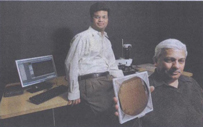DID YOU SEE?
ARTICLES
Democrat and ChronicleMarch 2008
Silicon wafers can keep data safe for centuries.
|
Knowledge lasts only as long as the medium storing it does. Yet paper pages crumble and microfilm fades.
A Henrietta archiving company, created out of work done at Rochester Institute of Technology, is hoping to give information a longer shelf life.
NanoArk Corp., which was launched last year and is based in RIT's High Technology Incubator just off campus, is starting work on signing up customers for the product it plans to roll out this year-a silicon wafer called Waferfiche etched with tiny images that will last for hundreds of years, at least.
Waferfiche uses the same technology as semiconductor manufacturing. The result is that one standard page can be etched into a tiny, four-square-millimeter image, and one six-inch silicon wafer can hold 3,500 pages, said company President and Chief Executive P. R. Mukund, a professor of electrical engineering.
The images are then readable by special viewing equipment.
The company and product grew out of work Mukund and a team of other researchers did in 2006 to preserve the decaying original writings of the founder of the Dvaita school of Hindu philosophy.
Ajay Pasupuleti, now the company's vice president for technology, came up with the idea of using the same technology used in semiconductor fabrication to create the tiny images while he was pursuing a doctorate in microsystems at RIT.
Mukund said he and the other researchers did not have any commercial applications in mind when they started the research work, but that they then heard from numerous people interested in it commercially.
University research, particularly from the University of Rochester and RIT, is one area of particular potential for the regional economy, said Rochester Business Alliance President Sandy Parker.
As the universities push for more of their research to be commercialized, Parker said, the result could be more businesses and jobs.
Unlike electronic means of storing information, Mukund said, Waferfiche will never become obsolete since it can be read even with a strong magnifying glass.
"Nobody now can read a 3.5-inch floppy," he said. "We can store all these things (digi-tally), but we may not be able to read from these mediums because things are changing so fast."
Meanwhile, microfilm and microfiche are difficult to search and require controlled environments for storage, he said.
NanoArk's process starts with documents or images being digitized and then etched onto the wafers. Meanwhile, data from the documents-such as certain key words-are put into a searchable directory.
Potential customers include banks, real estate companies, law firms and educational institutions, Mukund said.
By June, he said, the company expects to have a small manufacturing facility set up in its RIT incubator offices, as well as having a sales force.

 P. R. Mukund, right, president and
P. R. Mukund, right, president and